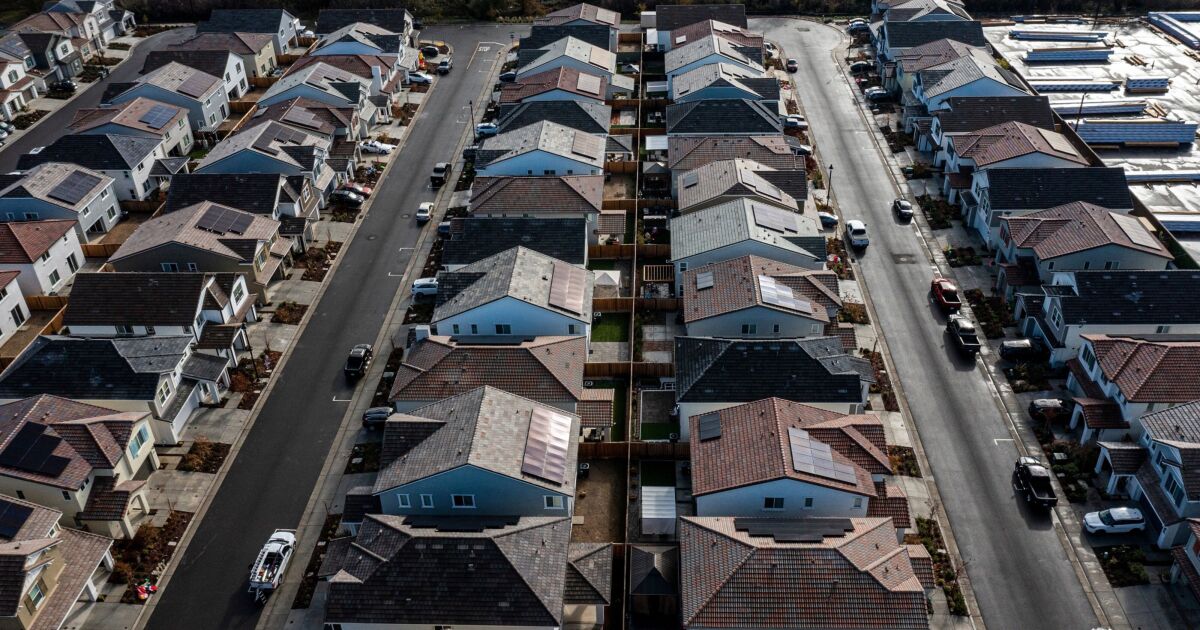
Homebuilders were a rare, bright spot in an otherwise dreary April for Southern California's housing market.
It's awfully hard to cheer when new-home sales in the six-county region fell 11.5% as the coronavirus crimped the economy. DQNews reported builders completed sales for 1,226 new residences last month, the slowest April since 2012.
But note what happened in the resale market: Only 12,600 existing homes and condos sold — down 33% in a year. It added up to the worst April for Southern California homebuying in DQNews records dating to 1988. Worse than the mid-1990s housing slump. Worse than the bubble-bursting Great Recession days.
The battle to thwart the coronavirus has hammered most of the economy, costing California more than one-fifth of its jobs. That kind of business disruption has meant at least 1-in-14 mortgage borrowers nationwide have some sought house-payment forbearance. It's no surprise that it's a scary time to be a house hunter, economically speaking. The same can be said about health fears, too.
In the middle of the turmoil, builders are one key to watch because they actually sell homes for a living. A huge reason existing sales have badly slumped: Many homeowners — the supply of existing resales to buy — pulled their properties off the market.
So builders, although a small slice of the local market, have products to show and sell to folks who have steady jobs and covet historically low financing rates.
Don't forget builders have one big hook: Their homes are "new" so when "cleanliness" is in high demand, freshly constructed housing can be comforting.
And builders also can offer what's usually considered a financial liabilities: finished but unsold homes. These "quick move-in homes" — or "QMIs" in industry lingo — are usually a drag on profits.
"The lack of inventory on the resale side has allowed builders an easy market share capture," said Ali Wolf, a building industry analyst with Meyers LLC. "What became a four-letter word during the Great Recession (QMIs) has now worked in the builders' favor as some consumers are looking to take advantage of the absurdly low mortgage rates."
The folks peddling new homes also seem willing to discount. Regionally, the new-home median selling price was $558,250, up only 1% in a year. Southern California's median price for existing homes was $572,000, up 7% in a year, and existing condos' median was $470,000, up 6%.
Research from Meyers shows roughly two-third of builders are promoting "concessions" — offers to help with closing costs, interest rates or upgrades. And quietly, maybe you'll find a few cutting prices at slower-selling projects.
"There's no deep discounting. But behind closed doors, you might probably see some incentives, 2% or 3%," says Leonard Miller, CEO of Orange County-based builder New Home Co. "If you have inventory, you're cutting deals."Remember, April is just one month. Closed sales represent buying decisions largely made before "pandemic" and "social distancing" were part of everyday thought. And builders' smaller-than-average sales losses were largely due to two hot counties: San Bernardino (up 41% in a year) and San Diego (up 8%).
Local builders also lost the market clout they once enjoyed.
Yes, their 9% share of local sales in April was up from 7% a year ago. But before the Great Recession — from 1988 to 2007 — newly construction residences represented 15.5% off all Southern California homes sold.
Opening a new home project in the middle of a pandemic is perhaps a bit of bad timing.
Remember March? Before we had new tools and rules on how to lower personal contact points for home sales during a pandemic.
New Home Co. debuted its Sterling community in Rancho Mission Viejo back then with no fanfare. Two months later, the first phase is "sold out," the company says, with 14 homes under contract.
It's a modest sales burst, and contracts are not closed deals. But it provides the builder some confidence to start construction plans for many of the remaining 46 lots.
"It's better than what we would have anticipated," says CEO Miller.
Sterling's single-family detached homes are part of a longer-term strategy by many homebuilders to move away from larger "McMansion" style houses popular just a few years ago. Wealthier buyers seeking multigenerational living have become a far smaller part of new-home shopping.
The Sterling homes are on narrow lots, roughly 4,000 square feet in total, in a conventional setup with a traditional driveway and two-car garage. The two-story residences hold up to five bedrooms and four bathrooms in as much as 2,595 square feet of living space.
Prices start "from the mid-$800,000s" and hit a curious sweet spot in south Orange County for move-up house hunters seeking anything under $1 million.
Miller knows competitors are making deals to move homes. But not at Sterling. Miller expects pricing to rise.
Virus fears forced New Home to cancel Sterling's March 21 "grand opening" festivities. The company quickly retooled its sales processes under "stay at home" government edicts to protect the health of house hunters and sales staff alike.
Virtual tours and robust online marketing have become the norm for first looks in all home selling. New Home, at first, arranged private showings without the aid of a sales office. It now offers onsite help with proper social distancing.
Miller admits March was a scary time with little buyer interest in any real estate. April brought some house hunters back out. Perhaps it was the turnabout in crashing stock prices, he suggests.
"Since Easter, every week's gotten a little bit better," he says. "We are encouraged."
Now Sterling is a noteworthy sales success in what's otherwise a dreary period. But New Home officials do admit to a few quirks that give Sterling an edge.
It's the last neighborhood to be built in the Esencia slice of Rancho Mission Viejo -- a popular master-planned community that won't have any other new homes until early 2022. And most of those Sterling buyers are currently residents elsewhere in Rancho Mission Viejo.
Across this master-planned community, builders put 28 homes under contract in Mat's first three weeks. That's down from 47 a year earlier but it's also 27% of Esencia's remaining homes left to sell.
"We are pleased to see such consistent home sales," says Nadine Corrigan, the community's vice president of marketing.
In an era where buyers and sellers are finding challenges to finishing a deal -- from suddenly picky lenders to job loss to overall skittishness -- closed sales may be the best indicator of the housing market's true health.
But "pending sales" tracking — tallies of signed sales contracts in the "escrow" process — can forecast what's next for closed transactions. And these deals-in-the-pipeline stats offer no signs of a quick rebound.
The Meyers' tracking of local builders selling pace is glum. In April, pending sales in Los Angeles and Orange counties were down 55% from a year earlier. Inland Empire deals-in-progress were off 53%.
That's worse than one tally of escrows involving existing homes from Realtor.com: April drops in the four counties ranged from 39% in Orange County to 24% in San Bernardino.
These are the type of scary numbers that help explain a huge decline in an industry confidence index from the National Association of Home Builders. Optimism among developers in Western states fell to a seven-year low in April, then modestly "rebounded" in May ... to the second-lowest reading since 2012.
As a result, builders are doing what they do when they're nervous: slashing plans for more product. The days of constructing "spec" homes as a bet on future sales are long over. There's no vast supply of unsold new homes to swamp the market.
Statewide, builders filed 4,060 permits for new single-family homes in March, according to the Federal Reserve Bank of St. Louis. That's a 40% drop from February's post-recession high — and the largest one-month drop in records dating to 1988.
Meyer's Ali does find what she saw as a "silver lining" for new homes.
"The end of April and May picked up a bit," she noted. "Nowhere near back to healthy levels but an improvement, nonetheless. And surprisingly with the huge drop in sales, some builders in select communities have actually raised the price. Housing is more local than ever."



